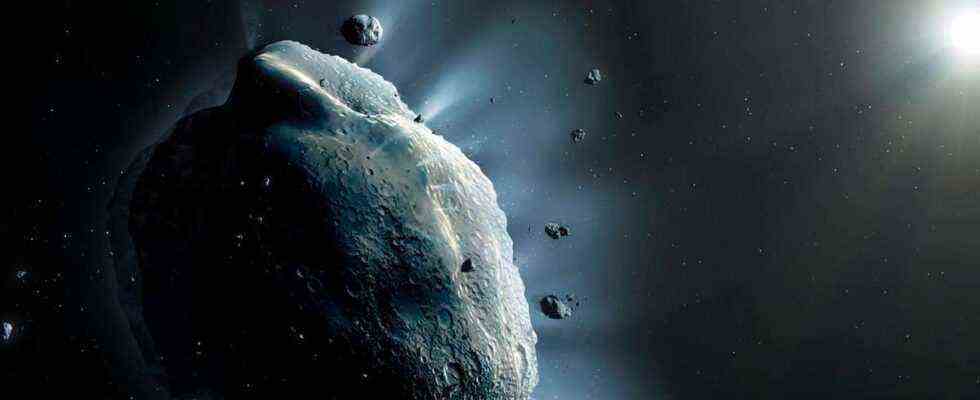fromTanya Banner
shut down
Not much is known about Asteroid 2022 AE1 – only two possible impact dates. After its discovery, it moves to the top of the risk lists of Nasa and Esa.
Frankfurt – It has a diameter of around 70 meters, has only been known for a few days – and has catapulted itself to number one on the “risk lists” of the US space agency Nasa and its European counterpart Esa: the asteroid with the name 2022 AE1. It was discovered on January 6, 2022 by the Mount Lemmon Survey, a system that automatically looks out for near-Earth objects and potentially dangerous asteroids.
Since the asteroid has only been known for a short time, its orbit is not yet entirely clear. However, since the asteroid is currently number one in the risk lists and is therefore considered to be more dangerous than the asteroid Bennu, it is now being closely monitored to collect further data. If there are more observations, the asteroid could quickly lose its top spot or be removed from the risk lists altogether. At the moment, however, the little data that is known about the asteroid has been used to calculate two dates on which the asteroid will come so close to earth that an impact cannot be completely ruled out.
Asteroid 2022 AE1 is number 1 on Nasa and Esa risk lists
For an impact of the asteroid on July 4, 2023, NASA gives a probability of 0.036 percent, Esa comes to 0.15 percent. For an impact on July 3, 2028, the given probabilities are even lower. At about 70 meters in size, the asteroid is slightly larger than the asteroid that is said to have triggered the so-called Tunguska event in 1908 – a violent explosion in Siberia.
There are other asteroids on the risk lists from Nasa and Esa whose probability of impact is higher than that of the newly discovered asteroid 2022 AE1 or which are larger than this celestial body. However, the lists are sorted according to the so-called Palermo scale – and this scale also includes when the possible impact will take place and how much time is left until then. While that’s only about a year and a half left at 2022 AE1, the earliest possible impact date for asteroid Bennu — it’s about 490 meters across — is in 2178.
Asteroid 2022 AE1: Impact in 2023 or 2028 possible – but unlikely
A second scale that assesses the risk of an asteroid impact is the Turin scale. This scale goes from 0 (“The probability of a collision is zero”) to 10 (“A collision is probable and capable of causing a global climatic catastrophe that endangers the future of civilization”), the asteroid 2022 AE1 is from the Nasa grouped in Tier 1. Nasa describes this category as follows:
A routine detection that predicts a near-Earth flyby that poses no unusual hazard. Current calculations show that the likelihood of a collision is extremely unlikely, with no cause for public attention or concern. New observations will most likely lead to the asteroid being classified as level 0.
Similarly, the asteroid (99942) Apophis was so notorious it was named after the Egyptian god of chaos. The asteroid with a diameter of about 350 meters was high on the risk lists for a long time, there were calculated impact probabilities in the years 2029, 2036 and 2068, among others. In the meantime, impacts for the three years and a long time afterwards have been ruled out and the asteroid Apophis was removed from risk lists after almost 17 years. Nevertheless, it remains interesting for research: On April 13, 2029, the asteroid Apophis approaches the earth to within about 31,000 kilometers and becomes a worthwhile research object.
How to react to a dangerous asteroid? NASA wants to test it in space
But how will humanity react if one day a dangerous asteroid is actually supposed to hit the earth? In 2021, Nasa launched a mission to test a theoretical reaction in practice: The “DART” space probe set off for a double asteroid, where it is supposed to push a small asteroid out of its orbit around a larger asteroid in autumn 2022 . The data from this test should help build the so-called planetary defenses on Earth.
Dangerous asteroid Bennu is examined by NASA spacecraft
Also, the Osiris-Rex spacecraft is on its way back from the asteroid Bennu. She collected rock samples there that should return to Earth in autumn 2023 and will then be examined by researchers. The probe had another important task: It was to measure the so-called “Jarkowski effect” on the asteroid, the influence of the non-uniform surface heating of asteroids on their trajectory. It is one of the biggest unknowns when calculating the trajectory of Asteroid Bennu in the future.
Subscribe to the free FR newsletter and stay up to date on current events in astronomy and space.
The trajectory of the asteroid 1994 PC1, which has a diameter of about one kilometer and will approach Earth on January 18, 2022, is now known more precisely. It is therefore one of the “potentially dangerous” asteroids – which does not automatically mean that it poses a danger. All asteroids that can come within 7.5 million kilometers or less of Earth due to their orbit and that have a diameter of at least 150 meters are automatically classified in the “potentially dangerous asteroid” category. The background: Asteroids from a size of about 150 meters can cause significant damage in the region in the event of an impact. The newly discovered asteroid 2022 AE1 does not fall into this category – it is too small. (tab)

